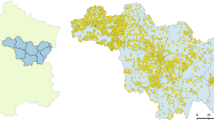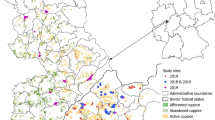Abstract
Metapopulation theory predicts that species richness and total population density of habitat specialists increase with increasing area and regional connectivity of the habitat. To test these predictions, we examined the relative contributions of habitat patch area, connectivity of the regional habitat network and local habitat quality to species richness and total density of butterflies and day-active moths inhabiting semi-natural grasslands. We studied butterflies and moths in 48 replicate landscapes situated in southwest Finland, including a focal patch and the surrounding network of other semi-natural grasslands within a radius of 1.5 km from the focal patch. By applying the method of hierarchical partitioning, which can distinguish between independent and joint contributions of individual explanatory variables, we observed that variables of the local habitat quality (e.g. mean vegetation height and nectar plant abundance) generally showed the highest independent effect on species richness and total density of butterflies and moths. Habitat area did not show a significant independent contribution to species richness and total density of butterflies and moths. The effect of habitat connectivity was observed only for total density of the declining butterflies and moths. These observations indicate that the local habitat quality is of foremost importance in explaining variation in species richness and total density of butterflies and moths. In addition, declining butterflies and moths have larger populations in well-connected networks of semi-natural grasslands. Our results suggest that, while it is crucial to maintain high-quality habitats by management, with limited resources it would be appropriate to concentrate grassland management and restoration to areas with well-connected grassland networks in which the declining species currently have their strongest populations.




Similar content being viewed by others
References
Balmer O, Erhardt A (2000) Consequences of succession on extensively grazed grasslands for central European butterfly communities: rethinking conservation practices. Conserv Biol 14:746–757
Bergman K-O, Ask L, Askling J, Ignell H, Wahlman H, Milberg P (2008) Importance of boreal grasslands in Sweden for butterfly diversity and effects of local and landscape habitat factors. Biodivers Conserv 17:139–153
Borcard D, Legendre P, Drapeau P (1992) Partialling out the spatial component of ecological variation. Ecology 73:1045–1055
Chevan A, Sutherland M (1991) Hierarchical partitioning. Am Stat 45:90–96
Connor EF, McCoy ED (1979) The statistics and biology of the species-area relationship. Am Nat 113:791–833
Crist TO, Pradhan-Devare SV, Summerville KS (2006) Spatial variation in insect community and species responses to habitat loss and plant community composition. Oecologia 147:510–521
Douwes P (1976) An area census method for estimating butterfly population numbers. J Res Lepid 15:146–152
Drakare S, Lennon JJ, Hillebrand H (2006) The imprint of the geographical, evolutionary and ecological context on species-area relationships. Ecol Lett 9:215–227
Erhardt A (1985) Diurnal Lepidoptera: sensitive indicators of cultivated and abandoned grassland. J Appl Ecol 22:849–861
Ewers RM, Didham RK (2006) Confounding factors in the detection of species responses to habitat fragmentation. Biol Rev 81:117–142
Hambäck PA, Summerville KS, Steffan-Dewenter I, Krauss J, Englund G, Crist TO (2007) Habitat specialization, body size, and family identity explain lepidopteran density–area relationships in a cross-continental comparison. Proc Natl Acad Sci USA 104:8368–8373
Hanski I (1994) A practical model of metapopulation dynamics. J Anim Ecol 63:151–162
Hanski I (1999) Metapopulation ecology. Oxford University Press, Oxford
Hanski I (2005) The shrinking world: ecological consequences of habitat loss. International Ecology Institute, Oldendorf/Luhe
Hanski I, Gyllenberg M (1997) Uniting two general patterns in the distribution of species. Science 275:397–400
Hanski I, Pöyry J (2007) Insect populations in fragmented habitats. In: Stewart AJA, New TR, Lewis OT (eds) Insect conservation biology. Proceedings of the Royal Entomological Society’s 23rd Symposium, CABI, Wallingford, pp 175–202
Heikkinen RK, Luoto M, Virkkala R, Rainio K (2004) Effects of habitat cover, landscape structure and spatial variables on the abundance of birds in an agricultural-forest mosaic. J Appl Ecol 41:824–835
Hurlbert SH (1971) The nonconcept of species diversity: a critique and alternative parameters. Ecology 52:577–586
Kivinen S, Luoto M, Kuussaari M, Saarinen K (2007) Effects of land cover and climate on species richness of butterflies in boreal agricultural landscapes. Agric Ecosyst Environ 122:453–460
Krauss J, Steffan-Dewenter I, Tscharntke T (2003) How does landscape context contribute to effects of habitat fragmentation on diversity and population density of butterflies? J Biogeogr 30:889–900
Kruess A, Tscharntke T (2002a) Contrasting responses of plant and insect diversity to variation in grazing intensity. Biol Conserv 106:293–302
Kruess A, Tscharntke T (2002b) Grazing intensity and the diversity of grasshoppers, butterflies, and trap-nesting bees and wasps. Conserv Biol 16:1570–1580
Kuussaari M, Nieminen M, Hanski I (1996) An experimental study of migration in the Glanville fritillary butterfly Melitaea cinxia. J Anim Ecol 65:791–801
Kuussaari M, Heliölä J, Niininen I (2002) Results of the butterfly monitoring scheme in Finnish agricultural landscapes for the year 2001. Baptria 27:38–47 (in Finnish with English summary)
Kuussaari M, Heliölä J, Pöyry J, Saarinen K (2007a) Contrasting trends of butterfly species preferring semi-natural grasslands, field margins and forest edges in northern Europe. J Insect Conserv 11:351–366
Kuussaari M, Heliölä J, Pöyry J, Saarinen K (2007b) Determinants of local species richness of diurnal Lepidoptera in boreal agricultural landscapes. Agric Ecosyst Environ 122:366–376
Leibold MA et al (2004) The metacommunity concept: a framework for multi-scale community ecology. Ecol Lett 7:601–613
Loertscher M, Erhardt A, Zettel J (1995) Microdistribution of butterflies in a mosaic-like habitat: the role of nectar sources. Ecography 18:15–26
Mac Nally R (2000) Regression and model-building in conservation biology, biogeography and ecology: the distinction between—and reconciliation of—‘predictive’ and explanatory models. Biodivers Conserv 9:655–671
Mac Nally R, Walsh CJ (2004) Hierarchical partitioning public-domain software. Biodivers Conserv 13:659–660
MacArthur RH, Wilson EO (1967) The theory of insular biogeography. Princeton University Press, Princeton
Moilanen A, Nieminen M (2002) Simple connectivity measures in spatial ecology. Ecology 83:1131–1145
Morris MG (2000) The effects of structure and its dynamics on the ecology and conservation of arthropods in British grasslands. Biol Conserv 95:129–142
Murphy DD, Launer AE, Ehrlich PR (1983) The role of adult feeding in egg production and population dynamics of the checkerspot butterfly Euphydryas editha. Oecologia 56:257–263
Öckinger E, Smith HG (2006) Landscape composition and habitat area affects butterfly species richness in semi-natural grasslands. Oecologia 149:526–534
Ovaskainen O, Hanski I (2004) Metapopulation dynamics in highly fragmented landscapes. In: Hanski I, Gaggiotti OE (eds) Metapopulation biology: ecology, genetics and evolution. Elsevier, Amsterdam, pp 73–103
Pollard E (1977) A method for assessing changes in the abundance of butterflies. Biol Conserv 12:115–134
Pöyry J, Lindgren S, Salminen J, Kuussaari M (2004) Restoration of butterfly and moth communities in semi-natural grasslands by cattle grazing. Ecol Appl 14:1656–1670
Pöyry J, Luoto M, Paukkunen J, Pykälä J, Raatikainen K, Kuussaari M (2006) Different responses of plants and herbivore insects to a gradient of vegetation height: an indicator of the vertebrate grazing intensity and successional age. Oikos 115:401–412
Pykälä J, Heikkinen RK (2005) Complementarity-based algorithms for selecting sites to preserve grassland plant species. Agric Ecosyst Environ 106:41–48
R Development Core Team (2007) R: a language and environment for statistical computing. R Foundation for Statistical Computing, Vienna
Raatikainen KM, Heikkinen RK, Pykälä J (2007) Impacts of local and regional factors on vegetation of boreal semi-natural grasslands. Plant Ecol 189:155–173
Rosenzweig ML (1995) Species diversity in space and time. Cambridge University Press, Cambridge
Simberloff D (1972) Properties of the rarefaction diversity measurement. Am Nat 106:414–418
Steffan-Dewenter I (2003) Importance of habitat area and landscape context for species richness of bees and wasps in fragmented orchard meadows. Conserv Biol 17:1036–1044
Steffan-Dewenter I, Tscharntke T (2000) Butterfly community structure in fragmented habitats. Ecol Lett 3:449–456
Steffan-Dewenter I, Tscharntke T (2002) Insect communities and biotic interactions on fragmented calcareous grasslands—a mini review. Biol Conserv 104:275–284
Stewart KEJ, Bourn NAD, Thomas JA (2001) An evaluation of three quick methods commonly used to assess sward height in ecology. J Appl Ecol 38:1148–1154
Summerville KS, Crist TO (2004) Contrasting effects of habitat quantity and quality on moth communities in fragmented landscapes. Ecography 27:3–12
Swengel AB (2001) A literature review of insect responses to fire, compared to other conservation managements of open habitat. Biodivers Conserv 10:1141–1169
Thomas CD, Hanski I (1997) Butterfly metapopulations. In: Hanski I, Gilpin ME (eds) Metapopulation biology: ecology, genetics and evolution. Academic Press, San Diego, pp 359–386
Thomas CD, Hanski I (2004) Metapopulation dynamics in changing environments: butterfly responses to habitat and climate change. In: Hanski I, Gaggiotti OE (eds) Metapopulation biology: ecology, genetics and evolution. Elsevier, Amsterdam, pp 489–514
Tscharntke T, Steffan-Dewenter I, Kruess A, Thies C (2002) Characteristics of insect populations on habitat fragments: a mini review. Ecol Res 17:229–239
Vessby K, Söderström B, Glimskär A, Svensson B (2002) Species-richness correlations of six different taxa in Swedish seminatural grasslands. Conserv Biol 16:430–439
Watling JI, Donnelly MA (2006) Fragments as islands: a synthesis of faunal responses to habitat patchiness. Conserv Biol 20:1016–1025
Wettstein W, Schmid B (1999) Conservation of arthropod diversity in montane wetlands: effect of altitude, habitat quality and habitat fragmentation on butterflies and grasshoppers. J Appl Ecol 36:363–373
With KA (2004) Metapopulation dynamics: perspectives from landscape ecology. In: Hanski I, Gaggiotti OE (eds) Metapopulation biology: ecology, genetics and evolution. Elsevier, Amsterdam, pp 23–44
Acknowledgments
Juha Pöyry was supported by a grant from the Finnish Cultural Foundation. Collection of plant and butterfly/moth data was funded by the Finnish Ministry of Environment (for the project ‘Maintaining biodiversity in traditional rural landscapes—optimal management and area networks’ through the Finnish Biodiversity Research Programme FIBRE coordinated by the Academy of Finland). Finalisation of the manuscript was supported by the EU FP6 project COCONUT (SSPI-CT-2006-044346). Atte Moilanen helped us with the calculation of the habitat connectivities. Thomas O. Crist, Ilkka Hanski, Risto Heikkinen, Henrik G. Smith, Keith S. Summerville and an anonymous reviewer provided valuable criticism on the manuscript. Michael J. Bailey corrected the English language.
Author information
Authors and Affiliations
Corresponding author
Additional information
Communicated by Ingolf Steffan-Dewenter.
Electronic supplementary material
Below is the link to the electronic supplementary material.
Rights and permissions
About this article
Cite this article
Pöyry, J., Paukkunen, J., Heliölä, J. et al. Relative contributions of local and regional factors to species richness and total density of butterflies and moths in semi-natural grasslands. Oecologia 160, 577–587 (2009). https://doi.org/10.1007/s00442-009-1328-7
Received:
Accepted:
Published:
Issue Date:
DOI: https://doi.org/10.1007/s00442-009-1328-7




